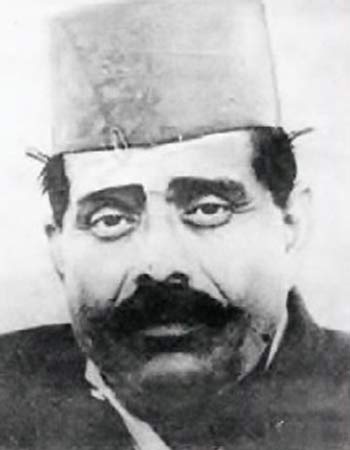In this article, we will discuss a sharp-minded persona Raja Natwar Lal who fooled almost everyone with his brilliance. He even sold the Taj Mahal and Indian Parliament by fooling foreigners. so let's go through his journey and darings.
Have you ever heard that a common person has sold the Taj Mahal? Would you believe that he even sold the Indian parliament too? You might be thinking that these all are absurd statements. But let me tell you that this happened in reality because of a Conboy, who did this crime a few decades ago, and who was commonly known as Raja Natwarlal. He was a guy who, using his cunning shyster and cunning methods, offered unimaginable fantasies in the shape of the Taj Mahal and duped people into believing him.
Today’s article is regarding such a conman who almost thuged everyone, from ordinary people to higher authorities. He even sold Parliament once and when caught by the police, escapes every time.
So let us go through the life of Natwarlal. His life and the crimes he committed.
Natwarlal Srivastava, who would later become Mithilesh Kumar Srivastava, was born in Bangra in the Siwan district of Bihar. Among his two brothers, he was the elder. As a station master, his father earned his living.
One day, Natwarlal's neighbor sent him to deposit his bank draughts, which is how he first learned to forge by duplicate signature. He was able to take 1,000 rupees out of his neighbor's account before he noticed after realizing how simple it would be to fake his signature. Natwarlal fled to Calcutta and registered as a student for a bachelor's in commerce while working as a part-time stock dealer. He made an unsuccessful attempt to start a fabric company as well. The British are rumored to have destroyed his home in Bangra, although his family still owns the property.
Case of fooling Jailor-
When Natwar Lal was in jail, he received a letter from his wife and due to the rule of jail, the letter is first read by the jailor. In the letter, it was written by his wife that there is no money left at home and they are not able to have a one-time meal. Firstly, Natwarlal ignored that, but when the letters come again and again with the same complaint, he wrote a letter to his wife which is as follows. He wrote to his wife, Don't worry, I will be released soon. While you wait, dig the plot near the house that is buried with a lot of ornaments.
After reading that letter, the jailor got shocked and dug the whole plot of Natwarlal’s house but found nothing. He interestingly dug the whole plot but as a result, found nothing.
Then he came back to Natwarlal and asked him if there was no ornament there, then why you gave them the wrong information? Natwarlal smiled and replied my wife doesn’t have enough money to dig the whole plot and I want to thank you that doing this freely now my ground crop will grow and by selling it, my wife will get some money. This was the sharp-minded activity of Natwarlal who fooled the jailor and left him bewildered.
Natwarlal was familiar with India's railway freight industry because his father worked as a station master. His bachelor of business degree and his time spent working as a stockbroker also helped him to become more knowledgeable about banking rules. He was skilled at forging documents and signatures, which enabled him to pull off the schemes.
After being caught for the first time in 1937 for stealing nine tonnes of iron, Natwarlal momentarily changed his tactics. He would routinely visit prostitutes, offer them poisoned wine, take their jewelry and money, and then disappear, according to the police.
Natwarlal rapidly concluded that this tactic was too dangerous; therefore he went back to con artists. He is charged with using more than fifty aliases to steal thousands of rupees from hundreds of company owners, jewelers, bankers, and foreigners. In the 1950s, he scammed the Punjab National Bank of 6.5 lakh rupees through a plan involving railroad freight and bags of rice. He routinely used cutting-edge ways to mislead people. He was quite good at copying the autographs of famous individuals.
The Tatas, the Birlas, and Dhirubhai Ambani are among the industrialists from whom he is said to have stolen a sizable sum of money. The members of parliament were reportedly included in Natwarlal's "sale" of the Parliament House to a foreign bidder. He occasionally claimed to be a social worker or a person in need in addition to assuming the roles of company manager and purchasing agent. He usually paid his victims with fake checks and demanded draughts.
Legend has it that Natwarlal served as a sort of Robin Hood in his hometown of Bangra.
He supposedly gave his earnings to the less poor. His heists, which mostly targeted the wealthy and powerful and tended to be non-violent, are what made him famous. An inhabitant of Siwan town reported that Natwartal drew huge audiences whenever he was there. According to one legend, Natwarlal once went to Bangra intending to organize a massive feast for the entire village with his wealth. Before leaving, he provided 100 rupees for each villager's necessities during the feast.
For a number of his high-profile crimes, Natwarlal was given severe penalties, and over time, the duration of his jail sentence expanded. In Bihar alone, Natwarlal was charged with 14 counts of forgery and sentenced to 113 years in prison. Natwarlal was arrested nine or ten times, but he mostly managed to get away. He often made cunning escapes.
For instance, Natwarlal escaped the Kanpur prison in 1957 by disguising himself as a local police officer, buying his way out of the building while the guards saluted him, and paid them off with a bag of cash. There were newspapers in the suitcase. As a result of his frequent efforts to escape from prison, it is believed that he only spent 20 years behind bars throughout his whole life.
Natwarlal was last imprisoned in 1996 at the age of 84. He was taken by the authorities from the Kanpur jail to the All India Institute of Medical Sciences in New Delhi for treatment, but despite his late age and use of a wheelchair, he was able to escape once more. On June 24, 1996, at the New Delhi train station, he was last observed by officials and was never seen again.
In Indian history, Natwarlal is regarded as the greatest con artist. In India, con artists who pull off extremely cunning scams are frequently referred to as Natwarlal, and many Indian con artists claim that his career served as an inspiration. It is thought that many of his alleged plans are urban legends, making it exceedingly challenging to reconstruct his genuine background. Arvind Jain, the Varanasi police superintendent, remarked about Natwarlal's career in 1987.
"He is really intelligent. He wasn't as poor as he claimed, in my opinion. Or the remarks about giving his money to the needy and abstaining from vices. He said. The residents of Bangra are proud that he was born and raised there. On the location of his old home, the community intended to construct a monument honoring Natwarlal in 2011.









